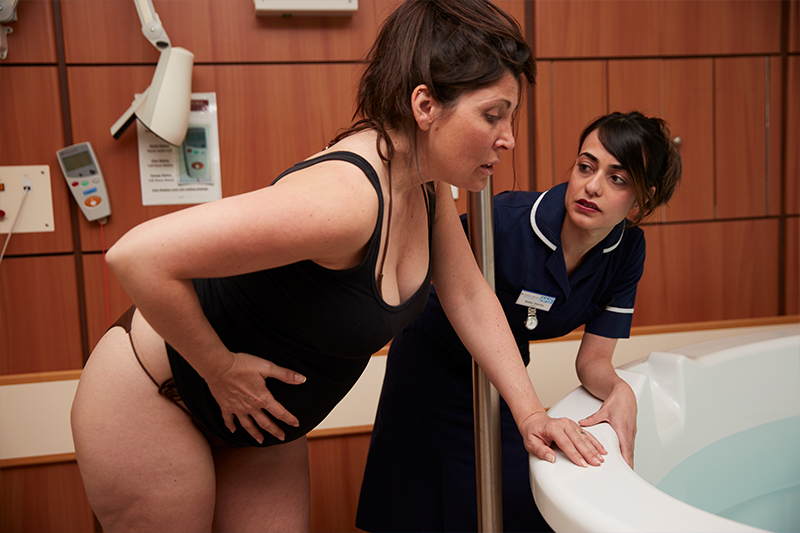Labor And Birth Pools: The Space Considerations

Labor And Birth Pools: The Space Considerations
Watch/Listen To The Video Version Of This Article
25th April 2017
Planning to put a labor and birth pool into a birth center or hospital takes some upfront consideration. Careful planning initially will pay off in the long run. By getting it right first time, you will have facilities that support good and safe practice for women and their babies, as well as your team.
This post is part of a series addressing the major issues you need to consider: space; water supply; drainage; and electrical supply.
Here, we take a look at space.
When you’re considering your space requirements, the key elements you need to consider are:
- Access to the woman in the birth pool
- Safe entry and exit from the pool in normal circumstances
- How she will get out of the pool in case of shoulder dystocia (more on this later)
- How your team will get her out in the unlikely event of her losing consciousness
Access to the woman in the birth pool
Essentially, you need to be able to easily, quickly and effectively access the woman in the pool, so you must factor this into your space considerations. For every labor in water you will need to monitor heart rate and maternal temperature, and for water births you need to catch the baby as it emerges. You can perform all these tasks with any type of pool.
Do you want to ask a woman in labor to change positions? An important factor when you are considering how much space you’ll need. For example, you will need to ask women to move more often in a pool placed in the corner than one that is open on three sides. If you choose the latter, then factor in at least two feet (60cm) of space on each side.
There is an increasing trend to placing freestanding pools against a panel in the corner of a room. Not only does this look great, it also offers good, all-round access.

Safe entry and exit in normal circumstances
Unless you are using a lift (known as a hoist in the UK), then women need to be able to get in and out of the pool with limited assistance – specifically, without your team bearing a significant part other weight.
To do this, you will need:
- An external step unit, either separate or integrated into the pool. This needs to be flat, with an anti-slip surface. Some steps have an integrated handrail – bear in mind this requires a large footprint for the step to ensure stability and makes the step heavier to move around.
- A step inside the pool. Please note that portable steps are not safe.
- Something to hold while stepping over into the pool, such as a handle (or the edge of the pool may be shaped to facilitate this). Remember that holding onto something at pool level will be below the woman’s center of gravity so for stability she will need to lean forward over the hand-hold location. Some hospitals place a floor-to-ceiling secured pole next to the step(s), which offers the benefit of allowing the woman’s hand to be above her center of gravity.
Clearly, criteria for using the pool are important too. If you want to be able to safely offer the pool to a woman who is not able to get into it without assistance, then perhaps you do need to consider a lift.
Shoulder Dystocia
With shoulder dystocia, you have limited time for action. Asking the woman to stand up and flex her pelvis with one foot on the step can remove it. But if this doesn’t work then the woman needs to get straight out the pool and onto a bed. In this instance, it’s critical to protect the baby’s head. You could try bringing a bed to the pool near the internal step, either length ways or sideways and approximately level with the pool deck (or rim). The woman can then step up onto the bed in a kneeling position, keeping the baby’s head well away from the hard surface of the pool.
This assumes that you have a mobile bed that can be brought next to the pool. You may want to consider keeping a mobile bed outside the room to preserve the “home-from-home” feel of your birth rooms.
Loss of Consciousness
While this is rare in labor, you must be prepared for it. Whether you plan to use a lift or a slide net – a net with handles designed for patient handling – it’s essential that your team is trained and confident in quickly getting a woman out of the water under these circumstances.
If the slide net option is not workable for you, then you will need a lift. If you have a permanent lift attached to the ceiling or on a gantry, then you won’t need to find space for a portable lift.
You also need to consider the necessary presence of able-bodied people: if your rota calls for two staff on site in the middle of the night, you will need at least one additional person to lift a woman out of the pool. One solution to this is to ask women to have a birth supporter present who is willing and able to be part of the lifting crew.
Conclusion
In this post, we’ve covered the main space considerations for rooms that include a birth pool. Any decisions should be made in close consultation with clinical managers, making sure that labor and birth pools support a safe, comfortable and practical birth environment for everyone involved.
Note that that in the UK, electrical regulations require a pool to be 10 feet from a power socket – factor that into your plans. For many countries, a GFCI (Ground Fault Current Interrupter aka RCD) is sufficient protection.
Check out our previous blog here for more information on Shoulder Dystocia.
Written By
Lies Jacxsens
Share this post on:
FEATURED POSTS
DOWNLOAD OUR FREE CATALOUGE
Water Birth Pools
Information
Connect With Us
Edel Immersys | Renton WA, USA & Birmingham, UK. All rights reserved © 2023 Edel Immersys




